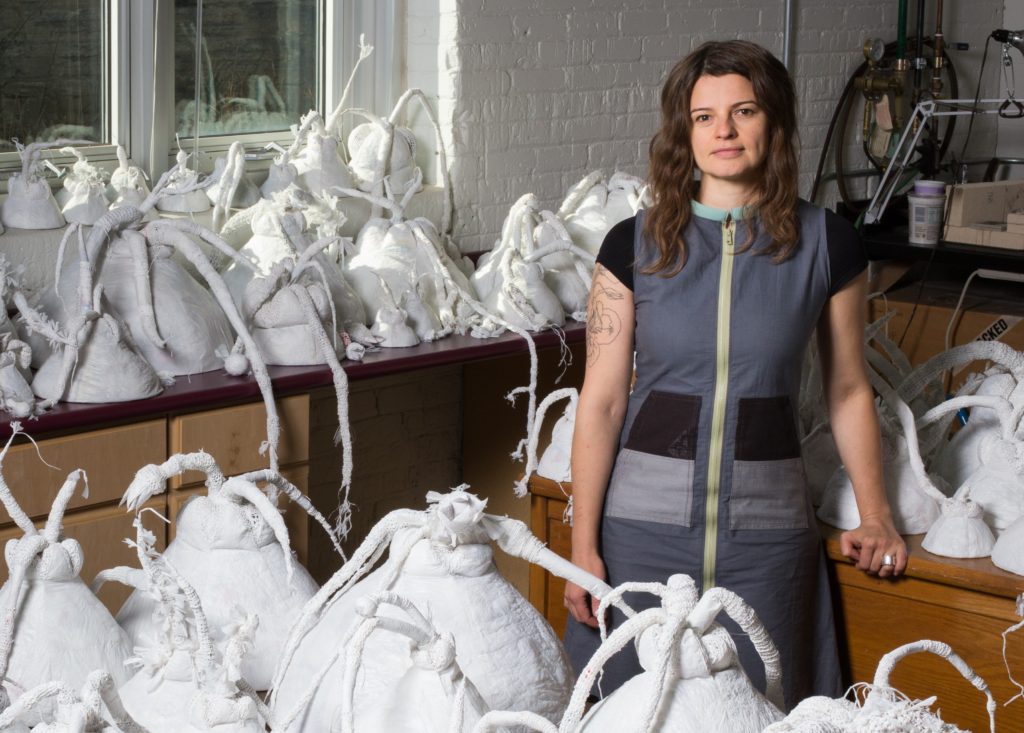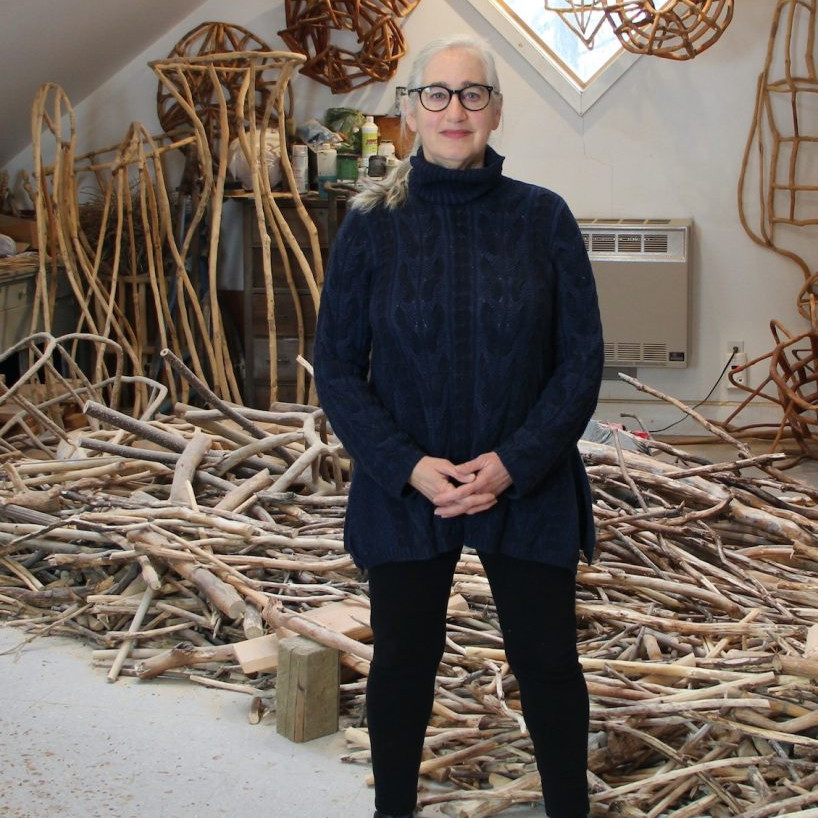Yevgeniya Kaganovich Jeweller, Sculptor, Installation Artist - Milwaukee, USA
Yevgeniya Kaganovich, Milwaukee, USA
How does Kaganovich find the time? With this complex mix, Professor and Associate Chair of the Department of Art and Design at the University of Wisconsin – Milwaukee. Head tof Jewellery & Metalsmithing as well as Digital Fabrication & Design Areas. Added to this Collaboration with other artists and personal art work.
You say you are ‘an object maker’ can you explain this?
My work has developed in distinct, but related directions: jewellery that explores materiality and cultural/social functions of adornment, sculptural body extensions defined by the corporeal body and the social environment, and installations that attempt to locate th
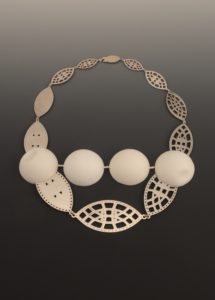
Pearl Clasp Necklace 2, rhodium plated sterling silver, porcelain, silk thread: 8 x 8x 5/8 inches, detail, Photo Credit: Yevgeniya Kaganovich
sculptural objects related to the body,
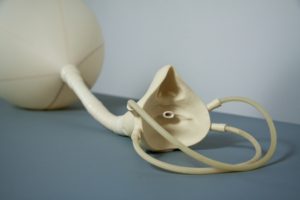
Detail, Double Mouth Piece 20, 6” x 5” x 1’ x 5”, Photo Credit: Yevgeniya Kaganovich
and object-based site-specific installations.

Grow, durational project finale, Lynden Sculpture Gardens, 2016, Reused plastic bags variable, Photo Credit: Yevgeniya Kaganovich
The physicality, the “objectless” of these projects is how I think through and communicate ideas, it’s how I understand and engage the world.
Throughout its various modes, my work is defined by my training and practice in Jewellery and Metalsmithing. My handling of the materials is informed by sensibilities that are prevalent in the making of jewellery and metal objects. The range of specific processes, methodologies and materials enhances my ability to engage in topics that are inherent to craft: wearability, the body, function, ritual, and preciousness. I firmly believe in the ability of creative objects to carry meaning and communicate ideas through their historical, social and cultural use. The advantage of originating in a craft discipline is the opportunity to utilize formats rooted within the applied tradition and employ craft strategies to create objects that explore and communicate ways of existing and making sense in the world. Craft scholar Lisa Norton stresses that craft has this inherent capacity to talk about “the stuff of life” through objects because craft, in general, is primarily about the body, use, and life1.
I strive to create objects and experiences, all in one way or another tangential to the applied tradition, whether it is through format, process, material, performance of labour, or the cultural implications of objects and locate them at the point of the body as the site of exchange. Through these objects, I explore ideas about being and making our way through life. The variety of material, format and process approaches allows me to address these concepts through objects, ultimately resulting in a hybrid practice.
Your work changes in scale what has led to this diversity?
The physical shifts in scale in my work coincide with shifts in modes of consideration of our bodies in relationship to objects meant for the body, our bodies in relation to each other, and our bodies in relation to our built or natural environment. jewellery is meant for the body, but it addresses ideas and functions in ways that are bigger than the body. I physically manifest this idea by, for example, manicuring small freshwater pearls into images of perfect large peals, albeit with silicone rubber. My sculptural body objects physically extend the ideas we have about ourselves and each other through connective rubber elements and inflatable volumes. And site-specific projects that engage our built or natural environments consider our bodies’ existence within them and project our effects on them.
Let’s start small.
Explain your fascination with pearls.
I am interested in the distance between “pearl “– the object and “pearl” – the cultural contract. Pearls have come to have so many different, sometimes diametrically opposing connotations: status, wealth, power, glamour, celebrity, purity, innocence, corruption, and seduction. The pearl operates as a signifier of these cultural constructs. But in reality, the pearl is this very unlikely object. Considering its origin, a pearl is a scar, an imperfection that has been glorified, elevated to a status of preciousness, and ascribed a high monetary value. For all of its cultural conditions, prestige and historical statue, it has meagre a beginning as a mere irritation, an anomaly. It gets even more complicated with cultured pearls: they are deliberate intrusions into live organisms, hybrids, mutants. And then there is nacre, the iridescent outer coating of pearls, which is a bit magical since its formation is not fully understood scientifically. It is secreted by a mollusc, its function is to smooth the shell surface and protect the soft tissues from debris/future pearls. The mollusc deposits successive layers of nacre onto a pearl all its life. We value the pearl based on how thick and lustrous its nacre is.
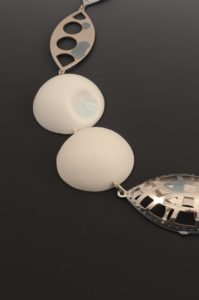
Pearl Clasp Necklace 4, 2012, Rhodium plated /sterling silver, porcelain, freshwater pearls, silk thread, glazed made by freshwater pearls fired to cone 13 lacquer, 8” x8” x5/8” Photo Credit: Yevgeniya Kaganovich
In my “pearl” work I attempt to think through some of these dichotomies. I examine the cultural value of pearls by transforming small freshwater pearls into an image of a large perfect pearl necklace. I juxtapose precious and experimental materials to question the cultural value of precious jewellery. Through blanking, silhouetting, inflating or flattening the image I am attempting to transform the work into iconic images of jewellery. These pieces are both literally and culturally images of a pearl necklace.

Pearl Necklace X, 2006, Potato pearls, silicone rubber, 14KW gold, silk thread, 81/2” x 91/2” x ½” Photo Credit Naomi Shersty
Expand on your findings on pearls during your residency in Hungary at The International Ceramics Studio.
I was fortunate to be included in a group of American and Hungarian jewellers who came together at the International Ceramics Studio for the “Sculpture to Wear” residency. Originally, I intended to work with porcelain as a precious material to explore the absence of pearls. I encased small freshwater pearls in thin porcelain disks, and my intention was simply to burn the pearls out, leaving an impression, a void of a precious jewel in a precious approximation of it. Instead, when fired, the pearls oozed out of the openings in a blue transparent glaze. I started firing whole and crushed pearls onto porcelain surfaces until I could control the amazing transparent blue droplets.
In the work that I subsequently made, freshwater pearls were transformed into puddles of lustre on the surface of an otherwise soft, slightly deformed large round porcelain forms. I slip-cast porcelain into images of pearls and give them “nacre” by melting actual freshwater pearls onto the surface. The fusing of the two precious materials, freshwater pearls and porcelain, changed both, creating a new kind of precious jewel.
This series utilized altered images of a traditional pearl clasp and porcelain “pearls”. I flattened, inflated, and graduated the clasps, disrupting their function in this transformation and making them into decorative elements. The title of this series, Function Fictions, refers to multiple dichotomies that I aimed to explore in this body of work: precious-non-precious, functional-decorative, jewel-setting/connectors/mechanisms.
In my mind pearls are almost mythical fictitious constructs. In this series large perfectly round pearls were approximated in porcelain, while real pearls serve as connectors. I was also creating a fictitious jewel by melting pearls onto the surface of porcelain. There was a lot of play with inverting and distorting the traditional functions of pearls as cultural, social and precious material constructs.
There was also a more direct inversion of functional elements, particularly the traditional pearl clasps, becoming decorative. They were inflated, graduated, fragmented, flattened, blanked out, and juxtaposed with negative silhouettes of pearls. Their decorative characteristics were played up to the point where they lose their use as mechanisms. Clasps became ornate decorative elements, hooks became “beads” and “pendants”.
You comment, ‘I am fascinated by the function of craft objects beyond utility’. Discuss.
The body is often the subject and/or the site, but function, whether it’s utilitarian, social, or evocative, is probably just as important to my practice.
In making jewellery I am interested in exploring the cultural and social functions of adornment. I am fascinated by the function of craft objects beyond utility. Specifically, I am interested in how jewellery functions to signal identity, power, fraternity and status as well as its ability to communicate ideas about the wearer, project the desired image, attract, and seduce. Much of how a piece of adornment functions is determined by the materials and the value attributed to these materials – this is the focus of much of my wearable work.
Throughout the long-standing series of body extensions, I address the complexities of inner personal and social interactions conditioned by the corporal body.
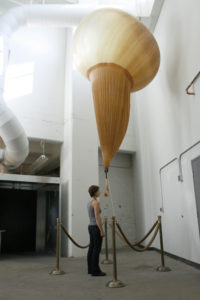
Balloon Mouth Pieces 11, cast rubber weather balloon, helium, plastic cord, stanchions, 22’ x 8”x 8” Photo Credit: Yevgeniya Kaganovich
I explore the absurdity of our attempts to express, perceive, communicate and understand. I think of the pieces I make as body extensions and as projections of mental habits and bodily knowledge. I aim to make objects that through their use comment on aspects of our existence, our experiences, our interactions, our bodies. I am interested in function as a point of access for the viewer and an opportunity to create meaning. It’s important that the work is not read as sculpture to be observed, but that it invites the viewer’s participation, whether actual or imagined. It’s through this engagement that the function and implications of each piece are considered.
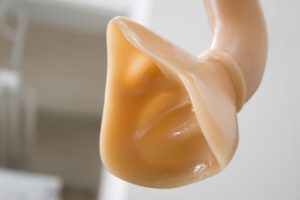
Balloon Mouth Pieces 11, detail, Photo Credit Naomi Shersty
While the objects I make mark the body as the site of exchange, in installation I attempt to locate the human body within architectural and cultural constructs and consider our existence within/effect on them.
You collaborate with other artists. Take a collaboration and explain how it evolved and how your work changed because of the collaboration.
Discuss your installation ‘Grow’
I’ve been really fortunate to have an opportunity to collaborate with a few amazing artists. While the subjects of these investigations are often consistent with my overall practice, collaborative work offers different and new ways to address these same ideas.

grow, durational project finale, Lynden Sculpture Garden, 2016, Photo Credit: Jim Charles
For me collaborations are always an exercise in letting go, giving up a certain amount of control for the sake of ending up somewhere new and different. My durational project grow, is probably the most extreme version of that. I was the initiator and the primary maker, but many other people, artists and non-artists, contributed their time, skills, and materials to the project. I developed the initial forms, processes and parameters for this installation, but I didn’t know how, where, or when it is going to end.
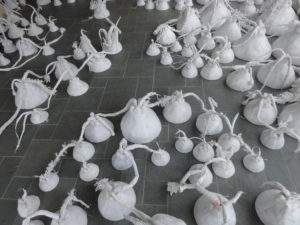
grow, durational project finale, Lynden Sculpture Garden, 2016, Photo Credit: Jim Charles
grow was series of durational installations in a number of public buildings throughout the city of Milwaukee and the surrounding areas. At each location, a system of interconnected plant-like forms, simulating a self-propagating organism in multiple stages of development, grew over time, utilizing reused plastic bags as a base material. The layers of plastic were fused together to create a surface similar to leather or skin, moulded into plant-like volumes, and connected with plastic bag “thread”, creating a system made out a singular material. I set up official plastic recycling bins at each location, where I periodically collected the bags and added to each organism. Like weeds, these organisms grew into unused spaces: niches, stairwells, and other peripheral architectural elements.
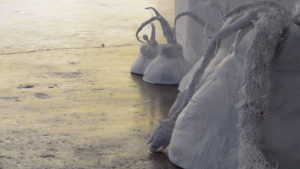
grow, durational installation project, Placing, the Golden Spike: Landscapes of the Antropocene, INOVA (Institute of Visual Arts), 2015, reused plastic bags, dimensions variable,
Photo Credit: Jim Charles
My goal in grow was to transform an artificial manipulated material into a seemingly unchecked, feral, opportunistic growth, to visualize and punctuate reuse by juxtaposing it with slow, methodical, labour-intensive making that plays with control, “craftiness”, and precision. Public involvement ranged from contributing plastic bags to the project to participating in workshops that I regularly held with my student assistants, who worked with me through a terrific undergraduate research program at my university.
The project launched in October 2012 at the Milwaukee’s Lynden Sculpture Garden. Since then there have been subsequent “plantings” at multiple locations throughout the city of Milwaukee, and also in Florida, Texas, and Pennsylvania.
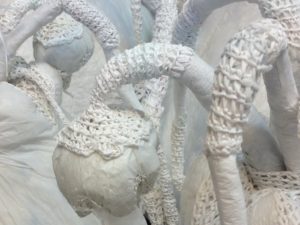
grow, detail, durational installation project, Aesthetic Afterlife, Haggerty Museum of Art, 2014, reused plastic bags, dimensions variable, Photo Credit: Jim Charles
From the beginning, I wanted to make something that was acting like an organic self-propagating organism, so I chose the most artificial material I could think of – plastic bags – and made “plants” out of it. Material is often at the centre of my practice: what it means, how it’s used, what can I do with it. I quite enjoyed the challenge of taking this ugly, unruly, disposable material and developing ways to work with it that would make is aesthetic, substantial, and convincing. These material contradictions, such as crocheting out of steel, casting feathers in concrete, or making walls out of actual feathers are often present in my work.
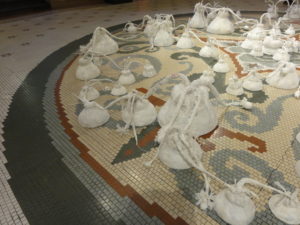
grow, Milwaukee City Hall, 2016, reusable plastic bags, dimensions variable,
Photo Credit: Yevgeniya Kaganovich
The way that this project was different from all other collaborations was that it necessitated the public engagement and I didn’t know where it was going to lead. I set up the parameters for the durational project, but within those, I had to give up quite a bit of control, be committed to incorporating all contributions, and just see where it was going to go. Polly Morris, the Executive Director of the Lynden Sculpture Garden, was instrumental in defining and encouraging the public component of growth, which was new to my practice.
My intent with the public component of the project was to help me tend to and grow and artificial organism. I wanted to make something that would not even exist without our care; it came into being by us propagating it. Interestingly, working with multiple students and workshop participants resulted intending to and growing a community. In the guise of tending to this artificial thing, I was really tending to and developing relationships.
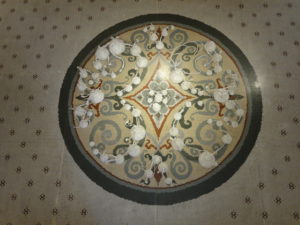
grow, Milwaukee City Hall, 2016, reusable plastic bags, dimensions variable,
Photo Credit: Yevgeniya Kaganovich
Public participation also underscored my intuitive sense of the project: no matter how much I’ve worked on this project daily, no matter how many people helped, no matter how long it took, we were never able to keep up with the speed of the refuse.
The installations varied greatly from one location to another, as all of them responded to the particular interior spaces. At the Milwaukee City Hall, in addition to filling in nooks and crannies with the sculptures, I installed them on the mosaic floor, confusing this “growth” with the decorative interior detail.
At all of the locations the forms could be moved around for cleaning or events; they could be treated very informally, but they had to be dealt with, they were in the way. This gave me an idea for the project finale. When all forms were transplanted back to Lynden for a final installation, instead of subsequently recycling them as was originally intended, we had a “come get your grow transplants” weekend. Many people came, got their transplants, took them home, and then had to figure out what to do with these consequences of our actions. Even though we transformed a huge amount of refuse into these material and labour dense objects, we still had to deal with them. It didn’t solve anything.
The final installation at the Lynden Sculpture Garden was largely defined by how many forms existed at that point. I was able to “plant” a very dense field of the “bulbs” in the Lynden’s Garden Room. I also took them outside and situated them between trees and the modernist sculptures that reside at Lynden, emulating how things grow in nature relative to one another and to build structures. This final outside iteration of the project landed it solidly between nature and sculpture.
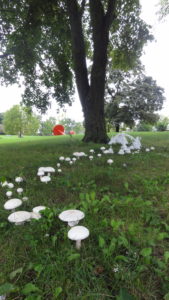
grow may yet have another lifecycle. I am currently working as part of a mycology focused artist collective, which includes three other artists: Lisa Moline, Lane Hall and Jim Charles.
Expand on your SGS/HED series. Discuss ‘How the objects have a sense of being both for and of the body and have both artefact and specimen qualities’.
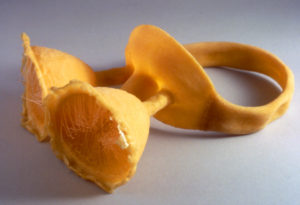
SGS / HED eyepiece 1, 2003, latex, nylon, food colouring, 4” x 11” x 12” Photo Credit: Yevgeniya Kaganovich
With SGS/HED series I strive to create objects that are ambiguous in their nature, their function hindered, their use frustrated and their origin unclear. In making a reminder of a hyped experience, I leave loose ends and don’t complete the total condition of the objects. I fuse the specimen and the artefact qualities to the point where it is impossible to identify the objects. Did they come off the body or are they meant to be applied to it? Are they tools or outgrowths? Are they prosthetics of some sort or interfaces meant to heighten a sensory experience?
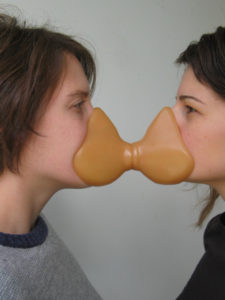
Double mouth pieces17, 2009, rubber cast; 4”x 61/2” x 4”
Photo Credit: Yevgeniya Kaganovich
These objects appear to be vulnerable and aggressive, fragmented and self- contained entities, all at the same time. The fusing of the artefact and the specimen qualities within a single piece lead to these objects having a sense of being both for and of the body. I render it as a tool and an outgrowth, as a device and an organism, all at the same time. These dualities result in a hybrid object that is frustrating and unclear, which allows for multiple readings of the work.
The more recent additions to this series retain this dual quality, are more explicitly devices rather than outgrowths. I have been focusing on implications of function, its possibilities and potential as a rhetorical device. In this work, I aim for the function to be transformative, not simply self-defeating, serve as key to understanding the objects.
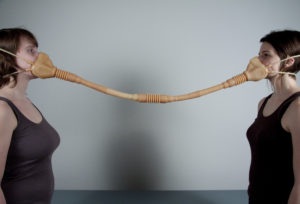
Double Mouth Piece 19, 2010, cast rubber; 4’3” x 5” x 7” Photo Credit: Yevgeniya Kaganovich
Double mouthpieces are sets of objects with impressions of a face on each end. Because of the absence of the straps, the only way to use the objects is for two people to stand in a very close proximity to one another, wedging the object between their faces, which can be uncomfortable or even suffocating. These objects undermine themselves through their own use; they beg engagement between two people only to reveal the difficulty of it. Thus, the physical challenges of using these objects uncover the social discomfort with such proximity.
The double mouthpiece connects two masks by a hollow tube. On each mask, the nostrils are open, which makes it possible to breathe into the piece. When in use, two people share the finite amount of air within the piece and their lungs, urgently connected and kept at a certain distance by the device.
The double mouthpiece has an inflatable volume to which two masks are connected. The openings of the mouths are equipped with one-way valves so that the air/sounds/words that go into and mix in the balloon do not come back out. This device puts two people in proximity but at a distance, the physicality of which is compounded by the psychological distance that is created by the complexity and the awkwardness of engaging the object.
balloon mouthpieces 11-14, are seemingly self-sustaining but ultimately self-defeating closed off systems.
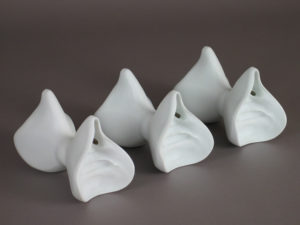
Double Mouthpieces 22 -24, 2010, porcelain, 33/4” x 6”x 33/4”
Photo Credit: Yevgeniya Kaganovich
They are inflated with helium, elevating the masks to a face level of an average height person. The pieces are tethered to stanchions which demarcate an area open on the entrance side. As with other work in this series, they orchestrate the viewer’s engagement through their specific directives: the height of the mask, the stanchions open on one side and the vinyl footprints on the floor are meant to solicit the viewer’s physical or intellectual participation. I shift the scale with these objects significantly, while still retaining the relationship to the body. Exaggerating the size creates tension between the imposing presence of the object and the minuscule details created by the bodily imprint, causing the viewer to constantly zoom in and out between the macro and the micro. Because of the exact indexing of the body, the object is quite specific in how the viewer is to engage with it, but the purpose and implications of this interaction are quite uncertain: does the viewer provide the object with breath, or does the object supply the viewer with some substance? This carefully orchestrated exchange remains ambiguous. The resulting object is unsettling, unclear, threatening, self-conscious and necessary. Whether the viewer acts upon it or it acts upon the viewer, the engagement is compulsory.
Plastic – is becoming a BIG topic and problem worldwide, how as an artist can you influence the appropriate use of plastic?
With grow, I wanted the “organism” to appear as a plausible ecological development; something that grew out of all that plastic debris, something feral overtaking its surroundings. This idea resonated particularly well once the forms were installed outside, making this speculation physical. The unfortunate thing is, a version of this is actually happening. Plastic has made its way into the geological layer: there is now volcanic rock with plastic compounds in it. My work is often a visualization and a reminder of these processes, physically placing objects in our way for us to deal with.
My projects that utilize reused plastic bags are not very effective in taking out a significant amount of this material out of circulation, nor do they process the waste in any way that is not going to be problematic to the enrolment in the long run. Seemingly, the function of the grow bulbs is to propagate and to reuse as many plastic bags as possible. But in that goal, we facilitate their growth, we propagate them, and we don’t take out plastic bags out of circulation to an extent that would matter. This attempt at reuse is ultimately futile.
This futility was built in to the project from the very beginning: even though these are super dense objects (8-300 bags each), no matter how long I work on the project, no matter how many students are a part of it, no matter how many workshop participants help, we are never able to keep up with the speed of refuse.
This project performs the act of reuse, it visualizes and punctuates it. We collect and process a lot of bags, making these dense labour-intensive things. grow makes this reuse visible, makes us slow down, sit down, work, think, and talk through the process. In the guise of tending to an artificial organism, grow ends up tending to a community that comes together for a conversation about reuse.
Show 2 or 3 pieces of your plastic jewellery and how it has evolved over years.

Red Berry Necklace, 2012, plastic bags, 34” x 6” x 21/4” Photo Credit: Michael Bernard
I started making wearable pieces, utilizing the materials and processes I’ve developed in making grow as a way to balance the durational project that took four years with finishing some concrete individual objects. It was also an opportunity to use all the colour plastic bags we were collecting. Some pieces became inside jokes on the rarity or abundance of certain plastic bag colours, such as All the Blue Bags and Some of the Red Bags necklaces.
In making the wearable pieces, I am expanding on the fabrication methods developed earlier, with more attention to detail, and a greater variety in textures and colours. I’ve used the leathery colour plastic bag sheet to make objects that look deflated. The inherent properties of the material make it possible to fuse the seams, have movable joints. I often articulate the hinges with a different colour.
In addition to working through the physical properties of these materials, I am thinking about what it means for us to carry the weight of this refuse on our bodies. Some of the latest pieces literally become weights. Relatively small in volume, they are heavy, they are physically weighed down.
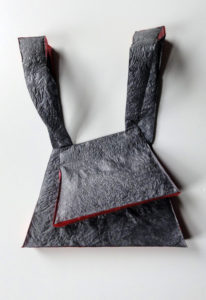
Deflate 3, 2015, reused plastic bags, plastic, 22” x 81/2 ” x 1 Photo Credit: Jim Charles
I am interested in using my making skills, developing new onces appropriate to the materials, and employing traditional craft processes. During a summer residency at the University of Oregon, Jovencio de la Paz, a fibers artist and faculty, taught me how to weave. Some of the latest wearable pieces are an accumulation of sheet, crocheted and woven surfaces.
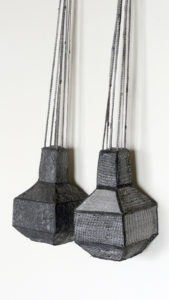
Gray/ Gray, Neckpiece, 2017, reused plastic bags, copper shot, 21” x 51/2” x 21/4”
Photo Credit: Jim Charles
Expand on how you work in three art practices, jewellery, sculpture, and installations.
As discussed above, physicality, “objectness”, material investigation, the body, function, and connection to the applied tradition link the various modes of my practice.
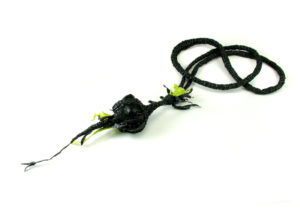
Green sprout Necklace, 2012, plastic bags 31”x 51/2” x 2” Photo Credit: Michael Bernard
I try to choose the formats that let me develop any particular idea in the most appropriate and effective way.
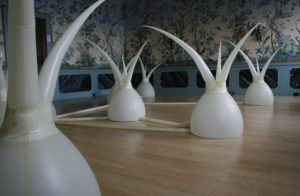
Yevgeniya Kaganovich with Nathaniel Stern, Strange Vegetation, 2011, installation, latex, plixiplass, air compressor, arduiono, prototype platform, relays and diodes, solenoid valves, ball valves, servo motors, computer and custom-built software, dimensions variable, Photo Credit: Naomi Shersty
I seek out venues and sites for my projects that make the ideas resonate, I look for communities that will find the ideas relevant and engaging.
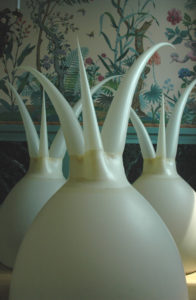
Strange Vegetation, 2011, detail, Photo Credit: Naomi Shersty
You are an Associate Professor in and Chair the Department of Art and Design at the University of Wisconsin – Milwaukee, how do you see your role in the growth of your students and courses available to them.
I am currently a Professor and Associate Chair of the Department of Art and Design at the University of Wisconsin – Milwaukee. I head the Jewellery & Metalsmithing as well as Digital Fabrication & Design Areas.
As a researcher, I see my role as contributing to the development of the craft field, expanding the understanding of the applied tradition and challenging its existing boundaries. The hybrid and collaborative nature of my practice necessitate proficiency with multiple processes, a range of approaches, and engagement with a variety of contemporary critical issues. This diversity of approaches to research has proven to be an asset to my teaching, as it allows me to bring a range of technical, conceptual, and critical perspectives to the classroom.
While at UWM, I’ve been particularly invested in curriculum, program, and facilities development. My role as an educator is to continuously improve our program and update the curriculum to keep it current and relevant to the contemporary discourse. To maintain and improve significant and positive student outcomes, I make sure students have access to a robust curriculum, safe and productive spaces, and a supportive and vibrant community. I focus on our students’ professional development and overall preparedness for a number of creative pursuits through competitive exhibitions, visiting artists events, and community engagement programming. I strive to develop relationships with students that foster their individual development, provide Opportunities that support their interests, and encourage them to contribute in an innovative manner. One of the most rewarding parts of my job is advocating for my students and the work that they do.
1 Norton, Lisa. “Individuation of Craft”, Craft in Real and Virtual World panel, College Art Association Conference, 2001
Contact details:
Yevgeniya Kaganovich
Yevgeniya Kaganovich, Milwaukee, USA
Interview by Deborah Blakeley, September 2018
Think a colleague or friend could benefit from this interview?
Knowledge is one of the biggest assets in any business. So why not forward this on to your friends and colleagues so they too can start taking advantage of the insightful information the artist has given?
Other artists you may be interested in:


